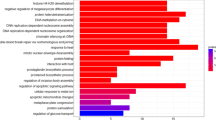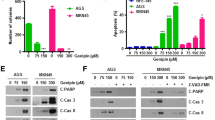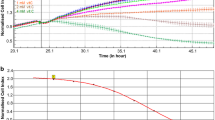Abstract
In a previous study, the lanthanum citrate complex ([LaCit2]3−) has been found to induce apoptosis in the human HeLa cervical cancer cell line. To clarify the mechanism, we carried out comparative proteomics analysis between treated and control cells. Differentially expressed proteins were separated electrophoretically and identified by MALDI-TOF/TOF tandem mass spectrometry. There were profound changes in 14 proteins related to mitochondrial function and oxidative stress, suggesting that mitochondrial dysfunction plays a key role in [LaCit2]3−-induced apoptosis. This was confirmed by a decrease in the mitochondrial transmembrane potential, and increases in cytochrome c release and reactive oxygen species generation in [LaCit2]3−-treated cells. Western blotting analyses show that [LaCit2]3−-induced apoptosis was accompanied by the activation of caspase-9 and the specific proteolytic cleavage of PARP, leading to an increase in the proapoptotic protein Bax and a decrease in the antiapoptotic protein Bcl-2. These results suggest that [LaCit2]3− induced the apoptosis of HeLa cells through oxidative stress mediated pathway involving MT participation.
Similar content being viewed by others
References
Dai Y, Li J, Li J, Yu L, Dai G, Hu A, Yuan L, Wen Z. Effects of rare earth compounds on growth and apoptosis of leukemic cell lines. In Vitro Cell Dev Biol Anim, 2002, 38: 373–375
Yu S, Yuan L, Yang X, Wang K, Ke Y, Qian Z M. La3+-promoted proliferation is interconnected with apoptosis in NIH 3T3 cells. J Cell Biochem, 2005, 94: 508–519
Yu S, Hu J, Yang X, Wang K, Qian Z M. La3+-induced extracellular signal-regulated kinase (ERK) signaling via a metal-sensing mechanism linking proliferation and apoptosis in NIH 3T3 cells. Biochemistry, 2006, 45: 11217–11225
Liu Y, Chen D, Jiang W. Anti-tumor effects of LaCl3 on hepatocellular carcinoma in mice (in Chinese). J Chin Rare Earths Soc, 2008, 26: 604–608
Li X, Zhou A, Yu W, Chen X. Effect of lanthanum citrate on two cell lines: human lung cancer cells PG and human gastric carcinoma cells BGC-823 (in Chinese). J Chin Rare Earths Soc, 2000, 18: 156–158
Meyers C A, Smith J A, Bezjak A, Mehta M P, Liebmann J, Illidge T, Kunkler I, Caudrelier J M, Eisenberg P D, Meerwaldt J, Siemers R, Carrie C, Gaspar L E, Curran W, Phan S C, Miller R A, Renschler M F. Neurocognitive function and progression in patients with brain metastases treated with whole-brain radiation and motexafin gadolinium: results of a randomized phase III trial. J Clin Onco, 2004, l22: 157–165
Heffeter P, Jakupec M A, Körner W, Wild S, von Keyserlingk N G, Elbling L, Zorbas H, Korynevska A, Knasmüller S, Sutterlüty H, Micksche M, Keppler B K, Berger W. Anticancer activity of the lanthanum compound [tris(1,10-phenanthroline) lanthanum(III)] trithiocyanate (KP772; FFC24). Biochem Pharmacol, 2006,71: 426–440
Liu H, Yuan L, Yang X, Wang K. La3+, Gd3+, and Yb3+ induced changes in mitochondrial structure, membrane permeability, cytochrome c release and intracellular ROS level. Chem-Biol Interact, 2003, 146: 27–37
Dong S, Zhao Y, Liu H, Yang X, Wang K. Duality of effect of La3+ on mitochondrial permeability transition pore depending on the concentration. BioMetals, 2009, DOI10.1007/s10534-009-9244-1
Yu S, Hu J, Yang X, Wang K, Qian Z M. La3+-induced extracellular signalregulated kinase (ERK) signaling via a metal-sensing mechanism linking proliferation and apoptosis in NIH 3T3 cells. Biochemistry, 2006, 45: 11217–11225
Wang Z M, Lin H K, Zhu S R, Liu T F, Zhou Z F, Chen Y T. Synthesis, characterization and cytotoxicity of lanthanum (III) complexes with novel 1, 10-phenanthroline-2, 9-bis-alpha-amino acid conjugates. Anticancer Drug Des1, 2000, 5: 405–411
Wang Z M, Lin H K, Zhu S R, Liu T F, Chen Y T. Spectroscopy, cytotoxicity and DNA-binding of the lanthanum (III) complex of an L-valine derivative of 1-10-phen-anthroline. J Inorg Biochem, 2002, 89: 97–106
Shen L M, Lan Z Y, Liu Q, Ni J Z. Apoptosis of cancer cells induced by lanthanum citrate (in Chinese). J Chin Rare Earths Soc, 2009, 27: 441–446
Shen L M, Liu Q, Ni J Z, Hong G Y. A proteomic investigation into the human cervical cancer cell line HeLa treated with dicitratoytterbium (III) complex. Chem Biol Interact, 2009, doi:10.1016/j.cbi.2009.07.013.
Crompton M. The mitochondrial permeability transition pore and its role in cell death. Biochem J, 1999, 341: 233–249
Gogvadze V, Robertson J D, Zhivotovsky B, Orrenius S. Cytochrome c release occurs via Ca2+-dependent and Ca2+-independent mechanisms that are regulated by Bax. J Biol Chem, 2001, 276: 19066–19071
Neuzil J, Wang X F, Dong L F, Low P, Ralph S J. Molecular mechanism of ‘mitocan’-induced apoptosis in cancer cells epitomizes the multiple roles of reactive oxygen species and Bcl-2 family proteins. FEBS Letters, 2006, 580: 5125–5129
Tsujimoto Y, Shimizu S. Role of the mitochondrial membrane permeability transition in cell death. Apoptosis, 2007, 12: 835–840
Duchen M R, McGuinness O, Brown L A, Crompton M. On the involvement of a cyclosporin A sensitive mitochondrial pore in myocardial reperfusion injury. Cardiovasc Res, 1993, 27: 1790–1794
Imberti R, Nieminen A L, Herman B, Lemasters J J. Mitochondrial and glycolytic dysfunction in lethal injury to hepatocytes by t-butylhydroperoxide: protection by fructose, cyclosporin A and trifluoperazine. J Pharmacol Exp Ther, 1993, 265: 392–400
Ni J Z. Bioinorganic Chemistry of Rare Earth Elements. Beijing: Science Press, 1995. 13–59
Mela L. Interactions of La3+ and local anesthetic drugs with mitochondrial Ca2+ and Mn2+ uptake. Arch Biochem Biophys, 1968, 123: 286–293
Gincel D, Zaid H, Shoshan-Barmatz V. Calcium binding and translocation by the voltage-dependent anion channel: a possible regulatory mechanism in mitochondrial function. Biochem J, 2001, 35: 147–155
Shoshan-Barmatz V, Gincel D. The voltage-dependent anion channel: characterization, modulation, and role in mitochondrial function in cell life and death. Cell Biochem Biophys, 2003, 39: 279–292
Cai J, Jones D P. Superoxide in apoptosis: mitochondrial generation triggered by cytochrome c loss. J Biol Chem, 1998, 273: 11401–11404
Kira Y, Sato E F, Inoue M. Association of Cu, Zn-type superoxide dismutase with mitochondria and peroxisomes. Arch Biochem Biophys, 2002, 399: 96–102
Li Q, Sato E F, Zhu X, Inoue M. A simultaneous release of SOD1 with cytochrome c regulates mitochondria-dependent apoptosis. Mol Cell Biochem, 2008, 322: 151–159
Blander G, de Oliveira RM, Conboy C M, Haigis M, Guarente L. Superoxide dismutase 1 knock-down induces senescence in human fibroblasts. J Biol Chem, 2003, 278(40): 38966–38969
Clemens M J, Bushell M, Morley S J. Degradation of eukaryotic polypeptide chain initiation factor (eIF) 4G in response to induction of apoptosis in human lymphoma cell lines. Oncogene, 1998, 17: 2921–2931
Morley S J, McKendrick L, Bushell M. Cleavage of translation initiation factor 4G (eIF4G) during anti-Fas IgM-induced apoptosis does not require signalling through the p38 mitogen-activated protein (MAP) kinase. FEBS Lett, 1998, 438: 41–48
Cipollini G, Berti A, Fiore L, Rainaldi G, Basolo F, Merlo G, Bevilacqua G, Caligo M A. Down-regulation of the nm23.h1 gene inhibits cell proliferation. Int J Cancer, 1997, 73(2): 297–302
Otero A S. NM23/nucleoside diphosphate kinase and signal transduction. J Bioenerg Biomembr, 2000, 32: 269–275
Author information
Authors and Affiliations
Corresponding author
Additional information
Supported by the National Natural Science Foundation of China (Grant No. 20637010) and the Shenzhen Bureau of Science, Technology and Information
Rights and permissions
About this article
Cite this article
Shen, L., Liu, Q. & Ni, J. Comparative proteomics analysis of lanthanum citrate complex-induced apoptosis in HeLa cells. Sci. China Ser. B-Chem. 52, 1814–1820 (2009). https://doi.org/10.1007/s11426-009-0272-z
Received:
Accepted:
Published:
Issue Date:
DOI: https://doi.org/10.1007/s11426-009-0272-z




